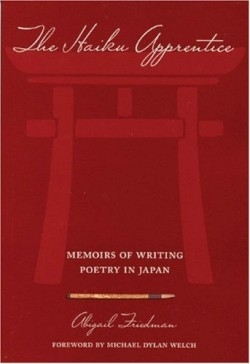The Haiku Apprentice
Memoirs of Writing Poetry in Japan
Every New Year’s Day, the Emperor and Empress of Japan host Utakai Hajime, the year’s first poetry reading, at the Imperial Palace. The poetic theme is announced in advance, and submissions arrive at the Imperial Household in the tens of thousands. When the Imperial family and members of the public recite their poems, the reading is broadcast on live television like a major sporting event. Official records trace the practice of Utakai Hajime to the thirteenth century. Currently in Japan, an estimated seven to ten million people write haiku every month.
The author of this memoir is a US diplomat twice stationed in Tokyo, where her official work focused on the less-than-lyrical topic of Northeast Asian security issues—in particular, North Korea’s nuclear ambitions. When she meets a retired businessman in Tokyo who introduces himself to her by his curious haiku nom-de-plume “Traveling Tree Man,” Friedman tells him: “Frankly, I don’t believe I have a poetic soul!” Yet after seven international moves in fifteen years, she unexpectedly finds herself tantalized by haiku—a poetic form that cultivates an intimate connection with one’s surroundings.
Legions of Westerners have pursued idealized notions of “traditional” Japan through enchanted forays into ikebana, martial arts, ink painting, or tea ceremony. The pitfall of such adventures is that they (sometimes willfully) overlook the more complex, ambiguous reality of contemporary Japanese culture and politics. In contrast, Friedman distinguishes herself through depth and rigor of inquiry, which ultimately leads to a revised understanding of both her host country and herself. She quietly earns her place in an all-Japanese haiku study group led by prominent haiku sensei or “master,” Kuroda Momoko. Haiku, Friedman discovers there, “is not an exclusive club for the spiritually adept few.” Instead, she has the rare fortune to experience poetry in a culture where it still exists as a social activity and “popular art, practiced by a wide range of people, and meant to be understood.” To make such an opportunity accessible to readers outside Japan, Friedman concludes with instructions on writing haiku in English, as well as starting a haiku group.
As Japan scholar William LaFleur has written, the rigorously condensed traditional Japanese forms of poetry are “best opened with care, close attention, and appreciation for the skill of the person who put so much into so small a container.” The practice of haiku, based on this finely tuned attentiveness to both environment and language, helps Friedman gradually locate a sense of belonging for herself in the midst of a diplomat’s nomadic life. In the process, her book becomes a deft and seamless merging of genres: at once memoir, travel literature, and an unpretentious guide onto the terrain of Japanese poetry. It will appeal not just to poetry lovers, but to all readers who are curious about the world beyond their own borders.
Disclosure: This article is not an endorsement, but a review. The publisher of this book provided free copies of the book to have their book reviewed by a professional reviewer. No fee was paid by the publisher for this review. Foreword Reviews only recommends books that we love. Foreword Magazine, Inc. is disclosing this in accordance with the Federal Trade Commission’s 16 CFR, Part 255.

